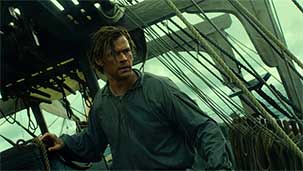There’s something about the sea that invites meditation and personal reflection. The undulating ripples, soothing repetition, brilliant blues. But that same sea can be terrifying. Crushing waves, a deafening roar, inky depths that have welcomed countless men down to sleep in Davy Jones Locker. This dichotomy is why seafaring adventures have captured our imagination for centuries. From Rime of the Ancient Mariner to The Perfect Storm, audiences know: when something goes wrong at sea, it often goes horribly wrong.
The same can be said of big-budget films.
No matter how many times you’re tasked with painting an ocean backdrop, I imagine each one is different. It takes a skilled hand to navigate such waters. Too light and it might come across as childish and shallow, too heavy and the result is murky, ugly, swamp-like. In the Heart of the Sea sails into both territories but never manages to find an even keel. Ron Howard has made a rollicking, effects-heavy sea adventure. He has also made a morality tale about class warfare and the hubris of resource depletion. And he has also made a relentlessly dark and mournful film about survival against the odds and the triumph of the human spirit.
Unfortunately they’re all the same film.
In the Heart of the Sea is an adaptation of the book that claims to be the true story upon which the American opus _Moby Dick is based. In 1820, a Nantucket whaling ship, The Essex, was destroyed by a sperm whale in the Pacific. Many of the crew lost their lives, and for the few who survived, the true story of what transpired on the ship remained a closely guarded secret. In 1850, Tom Nickerson, the last living survivor of the shipwreck, is visited by the writer Herman Melville, who pays him to tell him the story of what really happened on The Essex when he was just a boy of fourteen. The film flashes back to 1820 when experienced whaler Owen Chase, expecting to be made the captain of The Essex, is usurped by George Pollard, the son of a wealthy ship-builder. The conflict between the beloved and skilled Chase, and the cold and inexperienced Pollard threatens the entire expedition.
Any painter understands the importance of light and how to use it—in reflection, in shadow, in perspective. Howard, too, uses every opportunity to illustrate just how crucial whale oil was to lighting 18th Century America, and in doing so sets the visual tone for the film. In Nantucket, everything looks like an Old Master’s oil painting. From the slick cobblestoned streets, to the sunlight that streams through leaded glass windows. But there is grotesquerie here, too. In one particularly disgusting scene on The Essex, young Tom is dropped into a dead whale’s blowhole to retrieve the last of the oil, his lantern exposing the dripping, fatty innards of the beast’s head. Whaling is ugly business, but without it, Pollard reminds us, “The world would be plunged into darkness.”
It’s on the ocean where your work – and the film – visually come alive. Your paintings and the digital 3D elements complement each other beautifully, and we are treated to an abundant world above and below the water. Scenes of men harpooning a whale and being dragged along behind it, and of a particularly nasty storm, really showcase the harmony between your work and the CGI elements. And when we finally see the Great White Whale, the spectacle is quite literally breathtaking. It’s a shame, though, that the tone of the film gets lost at sea.
In the Heart of the Sea’s overlapping themes and one-dimensional characters feel conspicuously flimsy, especially against the film’s vivid realism and attention to graphic detail. The relentless formality of the dialogue, with its, “ahoys”, and “hoist the sails, Master Joy!” may be period appropriate but it feels like it was cribbed from an Errol Flynn swashbuckler. As the story plunges into grimmer territory, it is difficult to conjure up the pathos necessary to follow these characters on their somber journey since we’ve only ever been given sketches of who they are and what they stand for.
The golden rule of screenwriting is “show, don’t tell”, and, in this case, what we are shown far eclipses what we are told. It’s a pity. On the page, this story is thrilling and intense. On the screen, In the Heart of the Sea is hopelessly adrift.
Regards,
Di







